Decentralized and Collaborative Scheduling Approach for Active Distribution Network with Multiple Virtual Power Plants
Abstract
:1. Introduction
1.1. Motivation
1.2. Literature Survey
1.3. Contributions
- (1)
- At present, the application of SADMM in power system optimal operation is few. Aiming at solving distributed day ahead scheduling problem, the SADMM was used in the distributed active distribution system with multiple VPPs. On the premise of autonomous energy management of ADN and VPPs, decoupling the optimization models of virtual power plants and distribution networks without the participation of central coordinators was realized to achieve fully decentralized optimization. Compared with the traditional centralized optimization methods, the method proposed in this paper has good convergence performance. It can achieve the scheduling independence of each agent, protect the data privacy of each agent, and is more suitable for the environment of the power market.
- (2)
- This paper integrated distributed energy and large-scale EVs in distribution network through VPP cluster, and adopts two-stage stochastic optimization method including pre-scheduling stage and re-scheduling stage to deal with the stochastic uncertainty of distributed wind and light outputs, so as to realize the collaborative complementarity and overall optimization of the whole distribution system. Compared with the independent optimization mode of distributed energy and EV and the traditional deterministic scheduling method without considering the uncertainty of wind and light, the model in this paper can make full use of the advanced coordinated control technology of VPP to aggregate the distributed energy and EV groups. Furthermore, it can make full use of the mobile energy storage characteristics of EVs, then the adverse effects of disorderly charging and discharging of EVs and uncertainties of distributed wind and light power outputs on dispatching operation of active distribution network were alleviated.
- (3)
- The simulation results showed that the proposed decentralized optimization method based on SADMM has good convergence performance, it can converge to almost the same running cost as centralized optimization by 16 iterations. When the discharge loss cost of power battery is high, VPP will not reduce the operation cost because of V2G reverse discharge of EV. However, under the incentive of electricity price policy, the EV charging load during peak load period is transferred to the low load valley to charge, which effectively reduces the operation cost and peak–valley load difference. The proposed two-stage stochastic optimization method can ensure that the day-ahead scheduling plan can be transferred to various error conditions smoothly. Although the operation cost has increased, it can effectively deal with the uncertainty of distributed scenery.
1.4. Organization
2. Scheduling Model of Active Distribution System with Multi Virtual Power Plants
2.1. Active Distribution Network Scheduling Model
2.1.1. Objective Function
2.1.2. Constraints
2.2. Two-Stage Stochastic Schedule Model for Virtual Power Plant
2.2.1. Objective Function
2.2.2. Constraint Conditions in Prescheduling Phase
2.2.3. Constraints of Rescheduling Phase
2.2.4. Boundary Coupling Characteristics between Virtual Power Plant and Active Distribution Network
3. Distributed Collaborative Model Based on SADMM
3.1. Basic Principles of Standard ADMM Algorithm
3.2. The Basic Principle of SADMM Algorithm
3.3. The Solving Process
- (1)
- Set the iteration number = 1, initialize the algorithm parameters of SADMM.
- (2)
- Independently solve the ADN and VPP economic dispatch models in a decentralized manner.
- (3)
- To judge whether Equation (32) is satisfied, if yes, the iteration ends, or continue the next step.
- (4)
- , update the tie line interaction power according to the Equations (30) and (31), and turn to step (2).
4. Example Analysis
4.1. Basic Data
4.2. Result Analysis
5. Conclusions
Author Contributions
Funding
Conflicts of Interest
References
- Wei, Z.; Yu, S.; Sun, G.; Sun, Y.; Yuan, Y.; Wang, D. Concept and development of virtual power plant. Autom. Electr. Power Syst. 2013, 37, 1–9. [Google Scholar]
- Wang, Y.; Zhao, S.; Xu, Y.; Yin, J. Rolling dispatch of wind/thermal/storage system based on chance constrained goal programming. Power Syst. Technol. 2017, 41, 187–194. [Google Scholar]
- Gao, H.; Liu, J.; Wei, Z.; Cao, Y.; Wang, W.; Huang, S. A security-constrainted dispatching model for wind generation units based on extreme scenario set optimization. Power Syst. Technol. 2013, 37, 1590–1595. [Google Scholar]
- Qiu, H.; Zhao, B.; Gu, W.; Bo, R. Bi-level two-stage robust optimal scheduling for AC/DC hybrid multi-microgrids. IEEE Trans. Smart Grid 2018, 9, 5455–5466. [Google Scholar] [CrossRef]
- Gan, L.; Li, N.; Topcu, U. Exact convex relaxation of optimal power flow in radial networks. IEEE Trans. Autom. Control 2015, 60, 72–87. [Google Scholar] [CrossRef]
- Liu, Y.; Wu, W.; Zhang, B.; Li, Z.; Li, Z. A mixed integer second-order cone programming based active and reactive power coordinated multi-period optimization for active distribution network. Proc. CSEE 2014, 34, 2575–2583. [Google Scholar]
- Li, Q.; Ayyanar, R.; Vittal, V. Convex optimization for DES planning and operation in radial distribution systems with high penetration of photovoltaic resources. IEEE Trans. Sustain. Energy 2016, 7, 985–995. [Google Scholar] [CrossRef]
- Bahrami, S.; Therrien, F.; Wong, V.W.; Jatskevich, J. Semidefinite Relaxation of Optimal Power Flow for AC–DC Grids. IEEE Trans. Power Syst. 2017, 32, 289–304. [Google Scholar] [CrossRef]
- Dong, W.; Wang, Q.; Yang, L. A coordinated dispatching model for a distribution utility and virtual power plants with wind/photovoltaic/hydro generators. Autom. Electr. Power Syst. 2015, 39, 75–81. [Google Scholar]
- Pandzic, H.; Kuzle, I.; Capuder, T. Virtual power plant mid-term dispatch optimization. Appl. Energy 2013, 101, 134–141. [Google Scholar] [CrossRef]
- Zhuang, H.; Wu, H.; Liu, H. Multi-objective economic dispatch of microgrid system considering electric vehicles. Tran. China Electrotech. Soc. 2014, 29 (Suppl. 1), 365–373. [Google Scholar]
- Zhang, Q.; Liu, C.; Zhou, L. A bi-level economy dispatch model considering temporal and spatial optimal distribution of electric vehicles. Autom. Electr. Power Syst. 2014, 38, 40–45. [Google Scholar]
- Huang, Y.; Guo, C.; Wang, L.; Bao, Y.; Dai, S.; Ding, Q. A cluster-based dispatch strategy for electric vehicles considering user satisfaction. Autom. Electr. Power Syst. 2015, 39, 183–191. [Google Scholar]
- Pan, Z.; Zhang, X.; Yu, T.; Wang, D. Hierarchical real-time optimized dispatching for large-scale clusters of electric vehicles. Autom. Electr. Power Syst. 2017, 17, 014. [Google Scholar]
- Yang, J.J.; Zhao, J.H.; Wen, F.S.; Xue, Y.S.; Li, L.; Lv, H.H. Development of bidding strategies for virtual power plants considering uncertain outputs from plug-in electric vehicles and wind generators. Autom. Electr. Power Syst. 2014, 38, 92–102. [Google Scholar]
- Arslan, O.; Karasan, O.E. Cost and emission impacts of virtual power plant formation in plug-in hybrid electric vehicle penetrated networks. Energy 2013, 60, 116–124. [Google Scholar] [CrossRef] [Green Version]
- Shaaban, M.F.; Eajal, A.A.; El-Saadany, E.F. Coordinated charging of plug-in hybrid electric vehicles in smart hybrid AC/DC distribution systems. Renew. Energy 2015, 82, 92–99. [Google Scholar] [CrossRef]
- Wang, Z.; Chen, B.; Wang, J.; Begovic, M.M.; Chen, C. Coordinated energy management of networked microgrids in distribution systems. IEEE Trans. Smart Grid 2015, 6, 45–53. [Google Scholar] [CrossRef]
- Zhao, W.; Liu, M.; Zhu, J. A bi-level decomposition and coordination economic dispatch method for power plants/network considering stochastic wind generation. Power Syst. Technol. 2015, 39, 1847–1854. [Google Scholar]
- Zhou, M.; Wang, M.; Li, J.; Li, G. Multi-area generation-reserve joint dispatch approach considering wind power cross-regional accommodation. CSEE J. Power Energy Syst. 2017, 3, 74–83. [Google Scholar] [CrossRef]
- Boyd, S.; Parikh, N.; Chu, E.; Peleato, B.; Eckstein, J. Distributed optimization and statistical learning via the alternating direction method of multipliers. Found. Trends Mach. Learn. 2010, 3, 1–122. [Google Scholar] [CrossRef]
- Zhang, Y.; Giannakis, G.B. Efficient decentralized economic dispatch for microgrids with wind power integration. In Proceedings of the Sixth Annual IEEE Green Technologies Conference, Corpus Christi, TX, USA, 3–4 April 2014. [Google Scholar]
- Peijie, L.; Yong, L.; Xiaoqing, B.; Hua, W. Decentralized optimization for dynamic economic dispatch based on alternating direction method of multipliers. Proc. CSEE 2015, 35, 2428–2435. [Google Scholar]
- Erseghe, T. Distributed optimal power flow using ADMM. IEEE Trans. Power Syst. 2014, 29, 2370–2380. [Google Scholar] [CrossRef]
- Zhang, C.; Xu, Y.; Dong, Z.Y.; Wong, K.P. Robust coordination of distributed generation and price-based demand response in microgrids. IEEE Trans. Smart Grid 2017, 9, 4236–4247. [Google Scholar] [CrossRef]

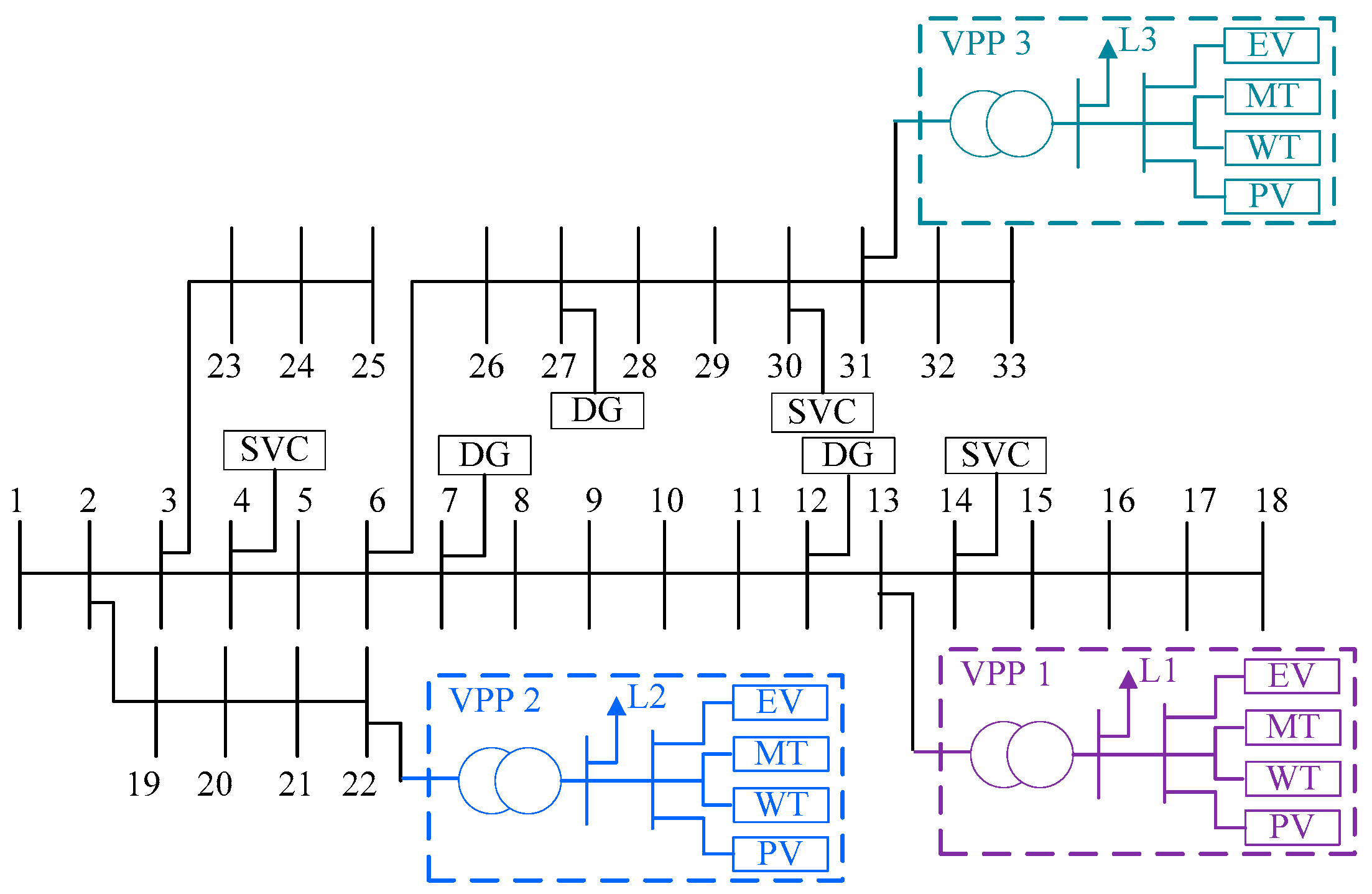

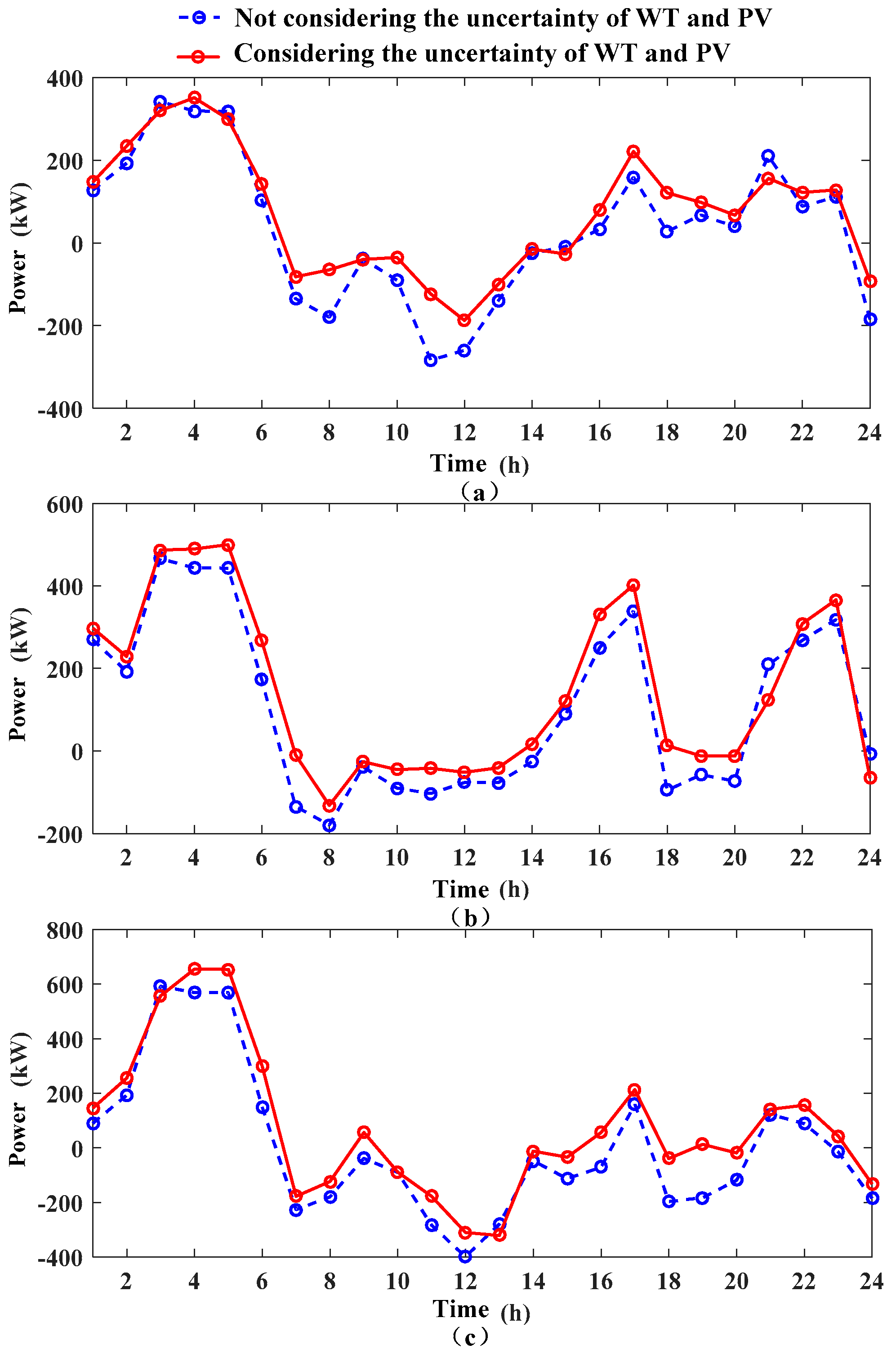
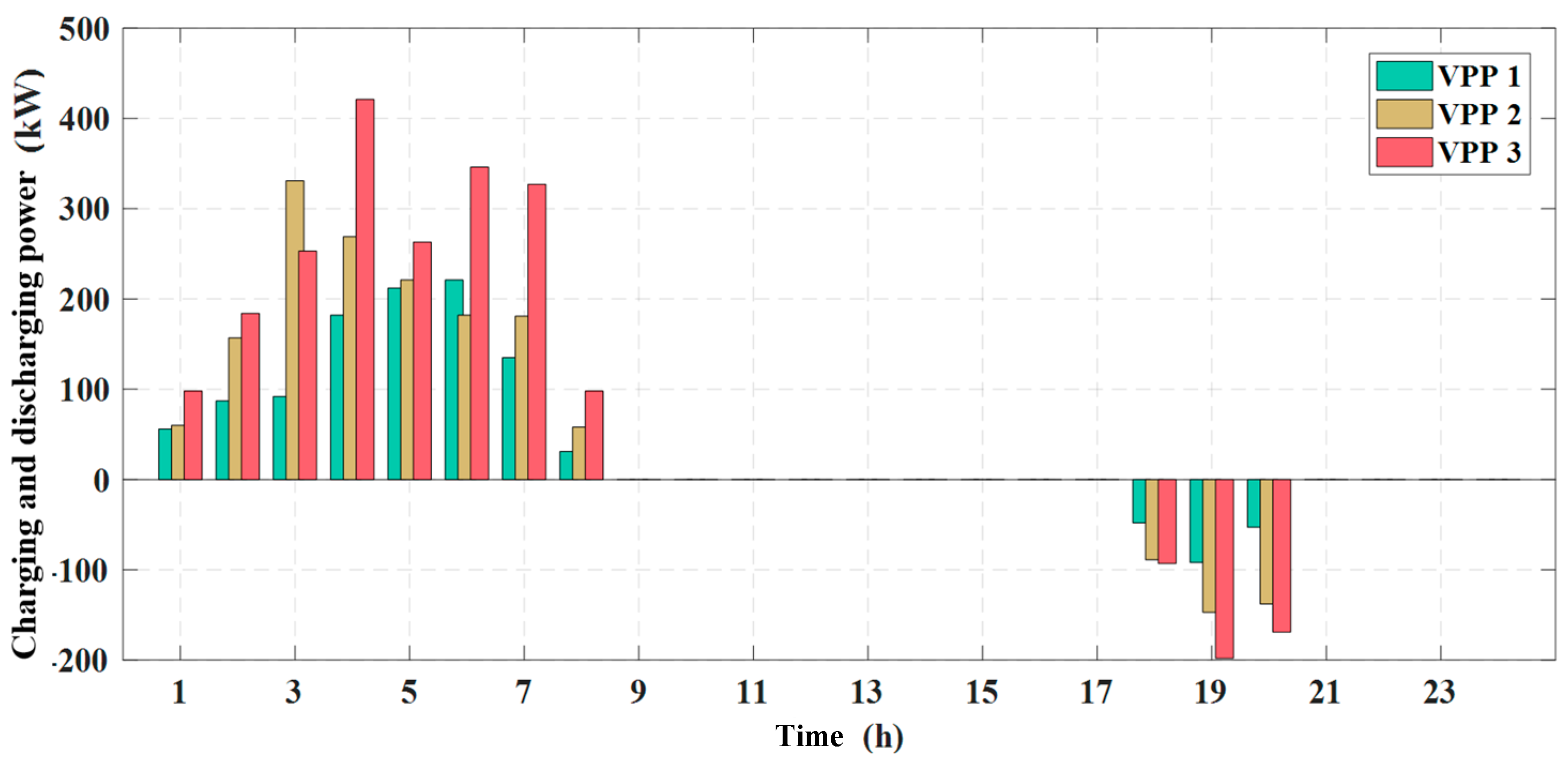

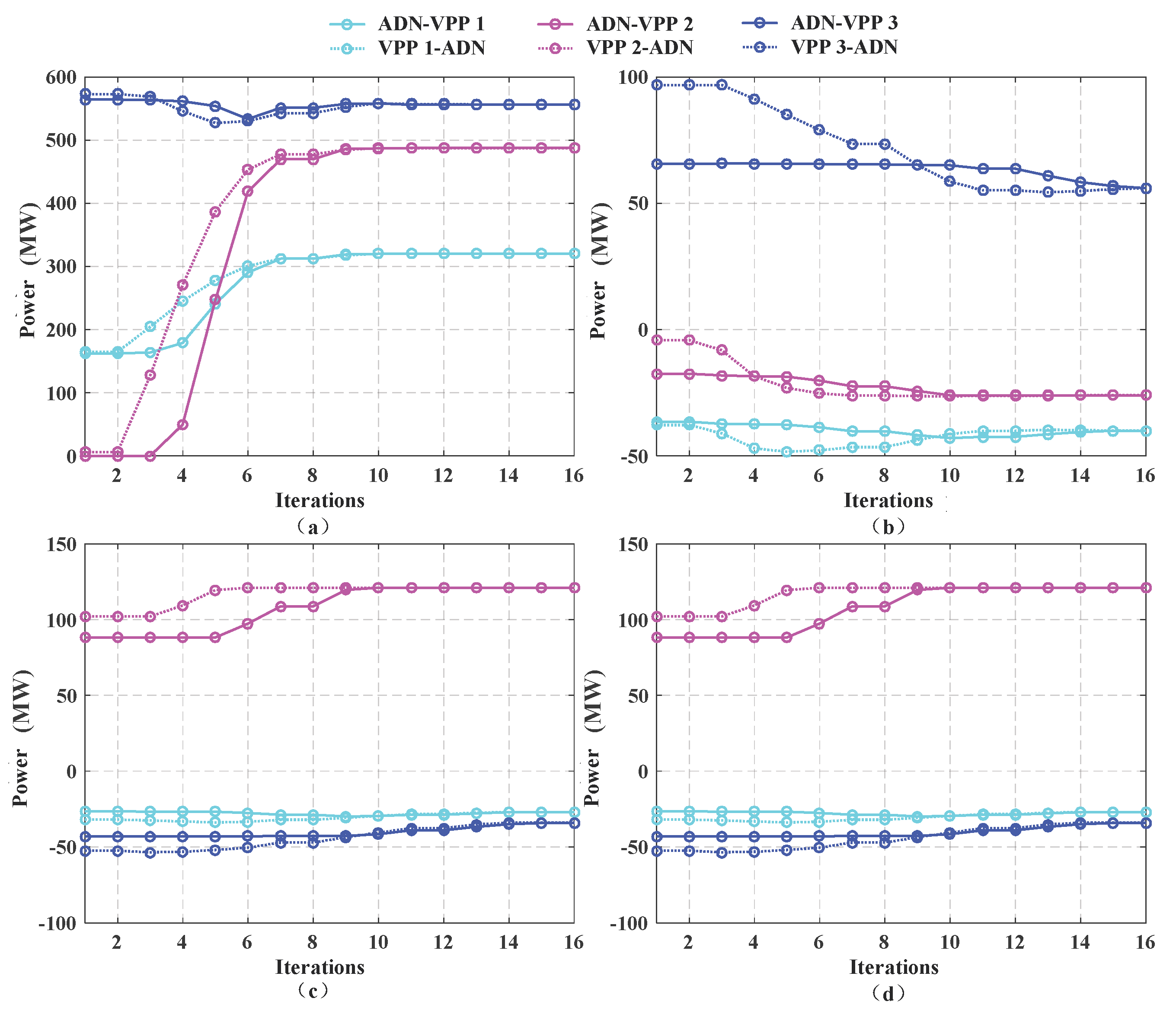
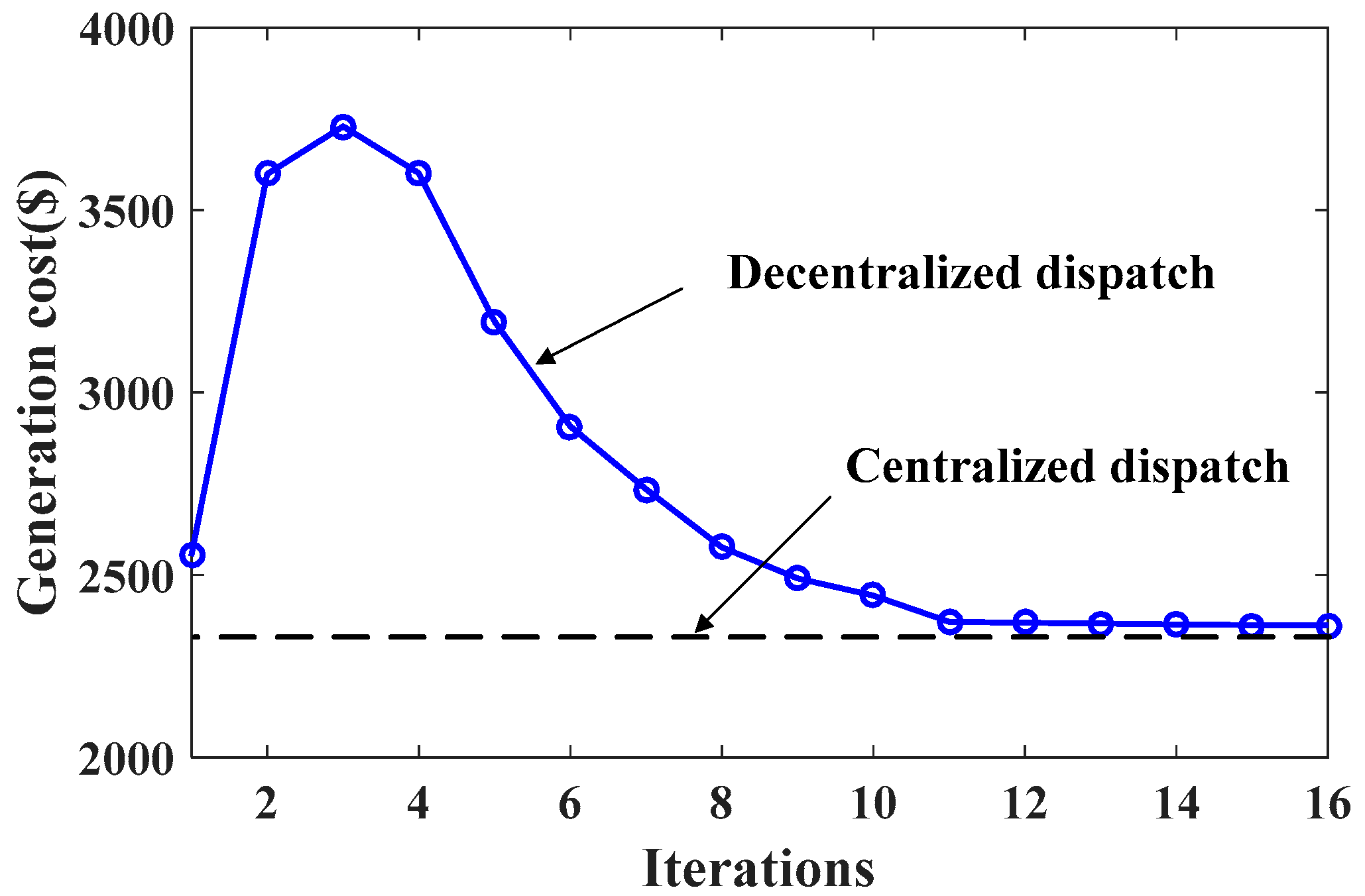
| Scheduling Methods | Prescheduling Cost/$ | Rescheduling Cost/$ | Total Cost/$ |
|---|---|---|---|
| Deterministic day ahead scheduling | 2118 | 0 | 2118 |
| Two-stage stochastic scheduling | 2079 | 282 | 2361 |
| Case | Model | Algorithm | Total Generation Cost ($) | Iterations | Calculation Time (s) |
|---|---|---|---|---|---|
| 1 | Deterministic | Centralized | 2287 | 1 | 3.5 |
| 2 | Two-stage stochastic | Centralized | 2303 | 1 | 20.6 |
| 3 | Deterministic | Decentralized | 2336 | 14 | 102.7 |
| 4 | Two-stage stochastic | Decentralized | 2361 | 16 | 192.4 |
© 2018 by the authors. Licensee MDPI, Basel, Switzerland. This article is an open access article distributed under the terms and conditions of the Creative Commons Attribution (CC BY) license (http://creativecommons.org/licenses/by/4.0/).
Share and Cite
Li, X.; Zhao, D.; Guo, B. Decentralized and Collaborative Scheduling Approach for Active Distribution Network with Multiple Virtual Power Plants. Energies 2018, 11, 3208. https://doi.org/10.3390/en11113208
Li X, Zhao D, Guo B. Decentralized and Collaborative Scheduling Approach for Active Distribution Network with Multiple Virtual Power Plants. Energies. 2018; 11(11):3208. https://doi.org/10.3390/en11113208
Chicago/Turabian StyleLi, Xiangyu, Dongmei Zhao, and Baicang Guo. 2018. "Decentralized and Collaborative Scheduling Approach for Active Distribution Network with Multiple Virtual Power Plants" Energies 11, no. 11: 3208. https://doi.org/10.3390/en11113208





